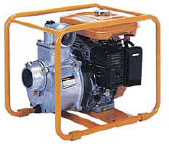MOTOR PUMP petrol (Robin EY15) 35m³/40m, 2"
Valid Article
MOTOR PUMP petrol (Robin EY15) 35m³/40m, 2"
Definition
Petrol motor pump used to pump water from 7 metre depth maximum and/or to deliver water to distribution systems (reservoirs, tap stands).
Can also be used as mobile pump with a tanker.
Suitable for discontinuous use.
Maximum yield: 35 m3/h.
Part of the kit KWATKPUP030 KIT MOTOR PUMP, PETROL, 30 m³/h max, 30 m max, 2"
Specifications
CLOSED ARTICLE (Robin EY15)
- Guillemin coupling 2" (ND50) at inlet and outlet.
- Elbow 90º for horizontal outlet
- Pump and engine mounted on a frame
- Oil security cut-off
- Maximum suction head: 7 m
- Maximum total head: 35 m
Instructions for use
Lightweight, easily installed pump. For an intensive use, it is better to select a diesel motor pump.
Check that the performance curve of the pump suits your situation.
Fill the oil pan prior to first use and check the level daily.
For the suction, use only the long spiral hose and strainer supplied in the kit.
On the discharge side, the 2" outlet assemblies (short spiral hose + gate valve and non-return) must be connected in between the pump and the pipeline to ease the disconnection of the pump and to prevent water hammering.
It is possible to create a distribution system with the pump delivering water from a reservoir directly to several tap stands without needing gravity. In this case, it is necessary to integrate the little piece of spiral hose and the T-piece (included in the kit) for the recirculation of water towards the reservoir when all taps are closed.
Prime the pump with water before starting.
Train the staff in proper operation, follow-up and maintenance of the pump.
Maintenance: every 60 hours. Fill in the maintenance logbook.
When stored for longer periods:
- Remove and dispose of old fuel from the tank
- Remove the remaining fuel from the carburettor
- Flush the pump case with clean fresh water, then completely drain it to prevent damage during storage
- Cover intake and discharge ports to prevent the entry of debris during storage
- Clean pump and engine, check for damage
For more detailed information and instructions see also the "Public Health Engineering in Precarious Situations", MSF, 2nd edition, 2010:
- T.B. 2.25 Centrifugal pumps
- T.B. 2.28 Motor pump kit installation


![[KWATKPUP030] KIT, MOTOR PUMP, PETROL, 30 m³/h max, 30 m max, 2"](/web/image/product.template/550989/image_256/%5BKWATKPUP030%5D%20KIT%2C%20MOTOR%20PUMP%2C%20PETROL%2C%2030%20m%C2%B3-h%20max%2C%2030%20m%20max%2C%202%22?unique=4d68811)